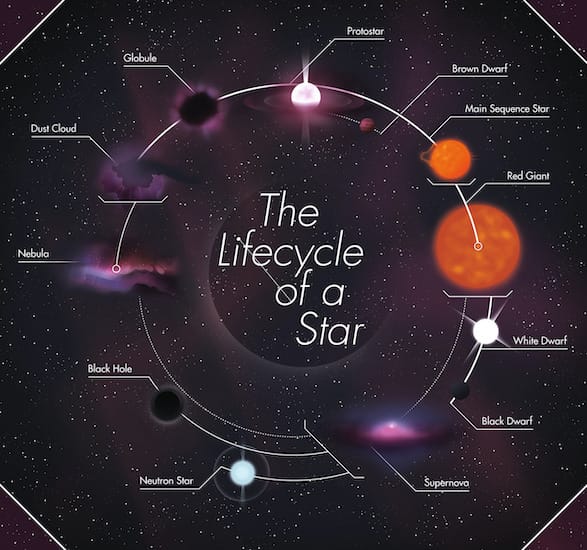The following steps are of the lifecycle of a star similar to the mass of our sun:
1. A mixture of dust, gas and elements – a glowing gas cloud that contains emission nebulas. An emission nebula is a cloud of hot, glowing cloud of gas and dust in space or a combination of elements. A gas cloud is the first step in the lifecycle of a star.
2. The ProStar is the second stage of a newborn star in a nebula. A new star is born because when the nebula contracts, it becomes are dense and hot and this is how a star is born and is on its first stage. The ProStar is it second stage and to reach the third stage it has to be at least 15,000,000-degree Celcius.
3. After a proto star the star may become a brown dwarf which is a type of substellar object that has a mass between those of the heaviest gas giant planets and the least massive stars.
4. If not a brown dwarf the star will continue to fuse hydrogen atoms to form helium atoms in their cores and become a main-sequence star. About 90 percent of the stars in the universe, including the sun, are main sequence stars. These stars can range from about a tenth of the mass of the sun to up to 200 times as massive.
5. A red giant is a luminous giant star of low or intermediate mass in a late phase of stellar evolution. The core of a red giant is contracting, but the outer layers are expanding as a result of hydrogen fusion in a shell outside the core. The star gets larger, redder, denser, and more luminous as it expands and cools. A fun fact – Blue stars are hotter than red stars.
6. Now in red giants’ core hydrogen was fusing into helium and becoming more dense. Now there will be a point in time when all that’s left is helium and that also will start to fuse, hence becoming even more dense while the surface becomes cooler and expands. Now when the core is at its highest density it will release of its energy in a flash – Helium Flash. The star is now more stable.
7. Now when the star is more stable the core will be replaced by oxygen and carbon (which is denser). There will be no more H or He plasma surrounding it and it will just be a dense ball of O, C releasing energy. That is called a white dwarf.
8. Now the white dwarf will emit all of its energy until it becomes a black dwarf- which is a dense ball not emitting any light of energy, hence its black and very hard to see. This is what’s going to happen to our sun.
The following steps are the lifecycle (after ‘red giant’ phase) of a massive star way bigger than our sun:
1. After the red giant phase, massive stars (9x sun) will start fusing into denser and heavier elements. The core will be of Fe56. The other elements include Silicon, oxygen, etc which form shells around the core. They will start forming layers of elements.
2. After the densest core (fe) is formed it cannot fuse anymore. It will require energy to fuse which doest support the core. Even the electron degeneracy pressure (force of electrons together) gives in. Enormous amounts of energy is released. To fend off this squeezing of the core, the rest of the star explodes in an unbelievably bright and energetic explosion – Supernova.
3. A neutron star is a celestial object of a very small radius (typically 30 km) infinite density, composed of closely packed neutrons. Neutron stars are thought to form by the gravitational collapse of the remnant of a massive star after a supernova explosion, provided that the star is insufficiently massive to produce a black hole.
4. The dense neutron star will give in to the electron and quark degeneracy pressure and form a black hole. A black hole is a region of spacetime where gravity is so strong that nothing—no particles or even electromagnetic radiation such as light—can escape from it. There are two types of blackholes – stellar and supermassive black holes.
5. A black hole with its very high gravitational pull will attract every single celestial object, light, or even electromagnetic radiation inside of its event horizon. A combination of stars or a similar solar system can revolve around it leading to form a galaxy. Yes, even our Milkyway has a black hole (4m solar masses) at the center!
You now know the lifecycle of stars and how galaxies are formed!
Featured image courtesy – https://futurism.com


Nicely explained. Looking forward for more 💫